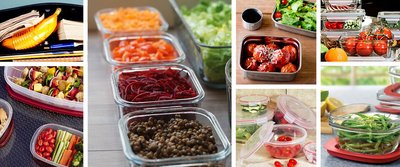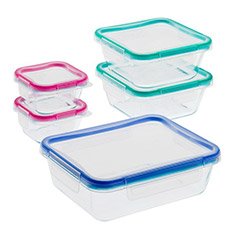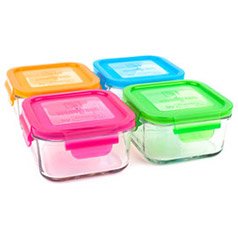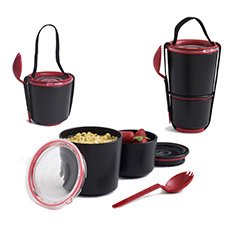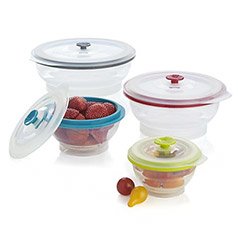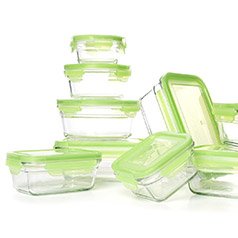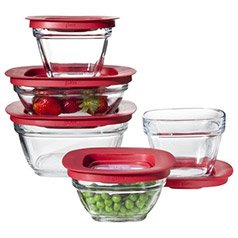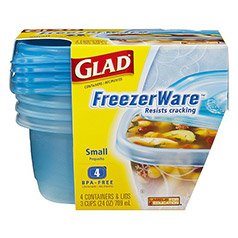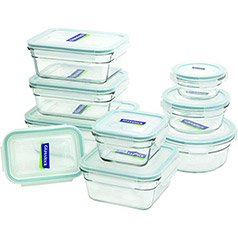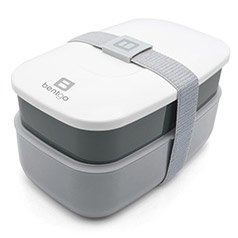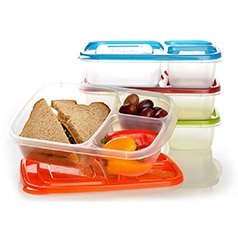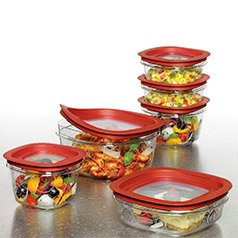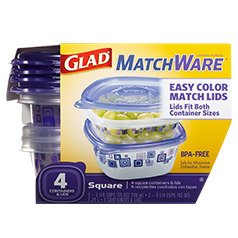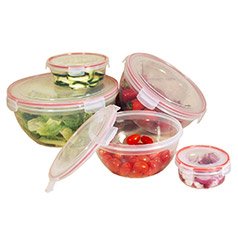As fellow fitness enthusiasts, you and I both understand that meal preparation is serious business. Meal prep, in which you prepare your meals in advance for the week, is often cited as one of the biggest influencers in determining fitness success or failure. Having food at the ready that fits your goals can quash hunger pangs before you make dietary decisions that leave you full of junk food—and regret.
The whole meal-prep process can essentially be broken down into these three basic components:
- Planning (shopping, recipes, daily meal breakdown)
- Preparation (cooking)
- Storage (weighing, packing away)
Simple, right?
Bodybuilding.com's extensive collection of healthy recipes and articles such as "Healthy Meal Planning Made Simple" and "5 Healthy Recipes to Hack Meal Prep" have the first two parts of the process locked down tighter than a cookie jar at a weight loss camp. Yet, barely a neuron has ever been devoted to the importance of the third component: storing the delicious fruits of your labor.
Until now.
Hey, proper storage is no laughing matter. I have had my fair share of spilled foods, leaky lids, microwave meltdowns, and other food-related tragedies that I'd now rather avoid, and you probably have too. You might be tempted to use any ol' container—maybe even reuse an old cottage-cheese container—but a proper food-storage container helps reduce spoilage by keeping air out and preventing fridge smells from permeating your goods.
Trust me, choosing the right storage containers for your precious meals and lifestyle can make a world of difference in convenience, organization, and frustration-free, on-the-go eating.
When shopping for good containers, take the following criteria into consideration:
1. Leak-proof and air-tight lids are the best
When it's lunch-o-clock, the last thing you want is to discover liquids from your food unexpectedly evacuating your supposedly closed container, making a frustrating mess inside your bag.
Truly, it's a hungry person's nightmare.
Some lids work better than others. Ideally, good lids will keep all contents inside the container, even if you play hot potato with it. You're probably most familiar with snap-ons, in which you just snap the lid and body of the container together. Snap-ons can be hit or miss, although many of the major brands like Glad and Rubbermaid know a thing or two about sturdy plasticware and leak-proof lids.
There are a few ways to test your lids:
- Lean the storage container on its side to see if gravity will draw out liquids. The best kinds of lids have some sort of seal, suction, or locking mechanism on the lid itself to hold it firmly to the container and safeguard precious food juices from seeping out.
- Shake it up for a full minute to see if the lids hold even while in motion.
- Drop them like they're hot (and sometimes they can be). Does the lid stay on? Does it crack anywhere?
A winning lid and accompanying container should survive at least two of those tests without a problem. Even if you're unlikely to bring liquid meals with you on the go, having a firm-fitting lid will save your bags from accidents.
Snapware Total Solution Glass Set
Mighty Nest Glass Containers
Black+blum Lunch Pot
2.Yuck, melted plastic
When plates and bowls are not readily available, most people simply eat their food directly out of their containers. (I mean, that's kind of the point of bringing portable food containers with you, right?) Except some containers and lids simply aren't made to be nuked in the microwave, and could warp or straight-up melt. Predictably, this also brings up health concerns over whether heating plastic containers directly in the microwave makes your food safe for consumption.
The jury is still out on this one, but the FDA recommends placing containers in the microwave only if they have been labeled for microwave oven use. These days it's hard to find a plastic container that can't hold its own in the microwave, but as they say, it's better to be safe than have sorry, melted plastic. So make sure the plastic containers are designed for microwave use, but if you're worried about it anyway, transferring your food to glass or paper—or just using a glass container to begin with—is usually the safer option.
Collapse It Cups
Snapware Glasslock
Rubbermaid Glass
Should you be worried about BPA?
A lot of attention has been on a chemical called bisphenol-A (BPA), which is added to make clear, hard plastic such as those found in reusable water and baby bottles. It's believed to be an "endocrine disruptor,"—or substance that mimics our natural hormones—which sounds pretty scary. However, the FDA closely regulates plastic containers that come in contact with food, and requires manufactures to pass specific tests that meet FDA standards and specifications. If you're still a bit wary about nuking your leftovers in plastic containers, try venting the container lid before sticking it in the microwave, and don't use old, scratched up containers, as they may be more likely to leak out BPA.
3. It's a cold world out there
Freezing your food can ensure its longevity, but this also subjects it to the harshness of sub-zero temperatures, resulting in freezer burn—you know, those nasty white splotches on food that make it taste like something you'd find at a wax museum. Worse, improperly frozen foods can absorb other smells and flavors.
Here's where freezer-friendly containers can protect the flavor, texture, and color of the food. They help reduce the food's exposure to air, which is responsible for many of the unwanted side effects of freezing. Proper freezer-friendly containers should be sealable and rigid; some glass ones, like Mason jars, can work, but make sure to give your food some room to crystallize and expand. Plastic freezer Ziploc bags can be awesome alternatives as well.
Freezer-friendly containers won't prevent freezer burn entirely, but they do go a long way in helping to preserve your food.
Reminder: The amount of time individual foods can be stored before their flavors and texture deteriorate can vary. Uncooked meat, for example, tends to store longer than cooked meat. Just make sure you label and rotate through your frozen foods in a timely manner.
Pyrex storage containers
Glad FreezerWare
Snapware's Glasslock
4. How portable is it?
Containers that fit easily in a travel bag or in small spaces are ideal. A lightweight, slimmer, flat-shaped container is probably a meal-prep veteran's best friend; it's the most versatile and portable, and fits most standard meals. In addition, containers come in all different sizes, which matters depending on what you intend to do and where you're headed with your food. If you're merely moving from point A to B—perhaps from home to the office—then portability probably matters less than for someone who bounces from point A to B to C and then to Z.
Bentgo All-In-One Stackable Lunch
Banana Bunker
5. But will it survive?
Whenever I shop, I'm looking for something that will go the distance, so durability factors greatly into any purchasing decision. The same goes when I'm buying food containers.
In my experience, containers need to be able to handle the wear and tear of everyday use, including the occasional tumble. I've already mentioned that food containers shouldn't melt in the microwave or crack in the freezer. Make sure they are durable enough to handle the microwave, the freezer, and the dishwasher.
Most food containers made by the major plastic and houseware manufacturers have all of these traits—well, unless you get glass ones, in which case you might want to skip the drop test.
Snapware Airtight Containers
EasyLunchboxes Compartment Bento Containers
6. Ease of cleaning
Spaghetti and other tomato-sauce-heavy foods can be a storage container's worst enemy, leaving behind crusty, hard-to-scrub lines along the surface and odors that won't leave. I find it extremely satisfying when I can simply rinse off food residue from just running water; how easily you can clean the storage container after use is therefore yet another thing to consider. Plus, if you wash your storage containers in bulk, it'll definitely need to be dishwasher safe.
I'm a big fan of glass and stainless steel containers simply for their ease of cleaning after each and every use. No fuss with endless scrubbing or funky smells.
Rubbermaid Premier
LunchBots Stainless Steel Containers
Snapware Total Solution
7. Containers that don't break the bank
With most of us preparing meals 1-2 weeks in advance and sometimes eating 3-7 times a day, it takes a truckload of storage containers to accommodate all of that food. The cost can add up!
Buy one set to get started. Beware that some sets will advertise having a certain number of pieces, but often this number includes the lids, meaning you're probably getting fewer actual containers. If you're willing to splurge, glass sets are really worth the purchase.
Glad Matchware Square
Rubbermaid 42-piece Easy Find Lid Set
Cook Pro 10-piece set
Glass Vs. Plastic
Trying to decide whether you should go with plastic or glass containers?




